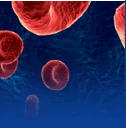  |
 |
|
||||||||||

Alveoli - Air cells of the lungs, formed by the terminal dilation of tiny air passageways. Antibody - A protein that is made by certain white blood cells (lymphocytes), in the body, in response to the invasion of a foreign substance. Antigen - A substance that when introduced into the body stimulates an immune response. Aorta - The main trunk of the arterial system, carrying blood from the left ventricle of the heart to all of the body except the lungs. Arteries - Blood vessels that carry blood from the heart to any part of the body. Bacteria - One-celled organisms, spherical, spiral, or rod-shaped and appearing singly, in chains, or in clusters. Blood - The fluid that circulates in the principal vascular system of human being and other vertebrates: in humans consisting of plasma in which the red blood cells, white blood cells, and platelets are suspended. Bronchi - The main branches of the trachea. Capillaries - The tiny blood vessels between the terminations of the arteries and the beginnings of the veins. Chemotaxis - Movement of a cell toward of away from a chemical stimulus. Cytoplasm - A jellylike material that surrounds the nucleus of a celland contains most of the cell's organelles. Differentiation - (of cells or tissues) to change from relatively generalized to specialized kinds, during development. Erythrocyte - A red blood cell. Fibrin - The insoluble protein end product of blood coagulation. Germs - Any microorganisms that cause disease. Granulocyte - A circulating white blood cell having prominent granules in the cytoplasm and a nucleus of two or more lobes. Hemoglobin - The oxygen-carryingprotein of red blood cells that gives them their red color and serves to carry oxygen to the tissues. Immunity - The condition that permits either natural or acquired resistance to disease. Leukocyte - A white blood cell. Lymphocyte - A type of white blood cell having a spherical nucleus surrounded by a thin layer of nongranular cytoplasm. B Lymphocyte - A lymphocyte that is involved in the production of antibodies. T Lymphocyte - A lymphocyte that helps in the priming of B lymphocytes to make antibody or is directly involved in attacking foreign cells, such as tumor cells. Marrow - A soft, fatty, vascular tissue in the interior cavities of bones that is a major site of blood cell production. Megakaryocyte - A large bone marrow cell having a lobulate nucleus (one with lobes); the source of blood platelets. Mitosis - The usual method of cell division. Monocyte - A large, circulating white blood cell, formed in bone marrow and in the spleen, that ingests large foreign particles and debris. Nucleus - The part of the cell that holds genetic information as DNA. Bacterial cells have no nucleus. Nutrients - Substances that give sustenance to an organism. Organelle - A specialized part of a cell having some specific function. Phagocyte - Any cell that ingests and destroys foreign particles. Phagocytosis - The ingestion of a smaller cell or a fragment. Plasma - The liquid part of blood or lymph, as distinguished from the suspended elements. Platelets - Small non-nucleated (having no nucleus) cells which form the first plug to stop bleeding. Red Blood Cells - One of the cells of the blood, which, in mammals, are non-nucleated disks concave on both sides, containing hemoglobin and carrying oxygen to the cells and tissues and carbon dioxide back to the respiratory organs. Spleen - A highly vascular, glandular, ductless organ, situated in humans at the cardiac end of the stomach, serving chiefly in the formation of mature lymphocytes, in the destruction of worn-out red cells, and as a reservoir for blood. Stem Cells - Cells that upon division replace their own numbers and give rise to cells that differentiate further into one or more specialized types, such as various B cells and T lymphocytes. Transfusion - The direct transferring of blood, plasma, or the like into a blood vessel. Veins - Branching vessels or tubes carrying blood from various parts of the body to the heart. Vessel - A tube or duct such as an artery or vein, which contains or conveys blood or some other body fluid. Virus - A tiny object that is composed of RNA or DNA and is surrounded by a protein cap or capsid. White Blood Cells - Any of various nearly colorless cells
of the immune system that circulate mainly in the blood and lymph.
|
||||||||||
| Copyright 2002 - |
